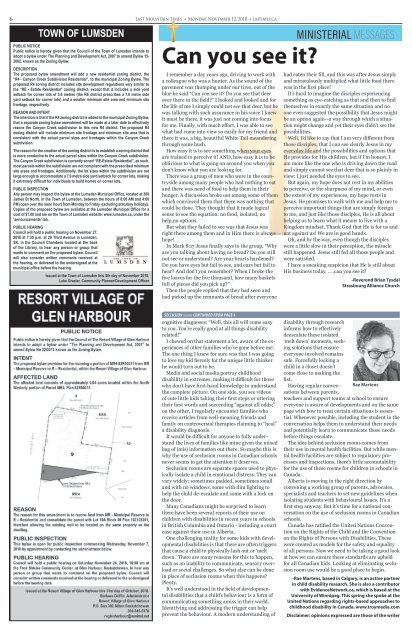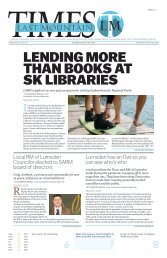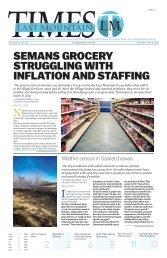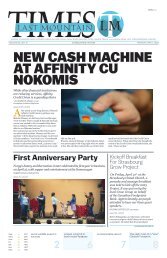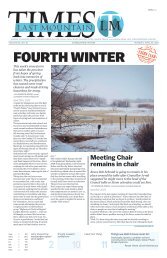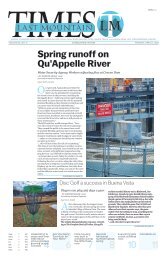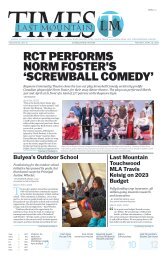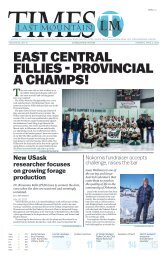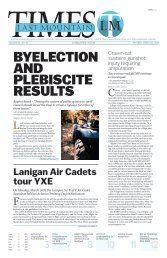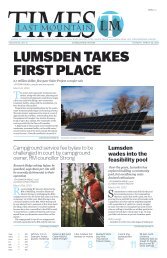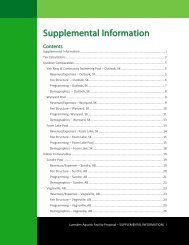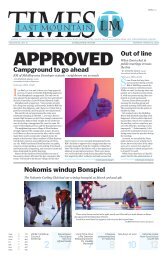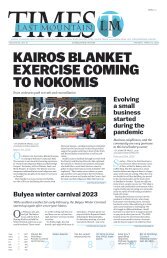LMT November 12 2018
- No tags were found...
You also want an ePaper? Increase the reach of your titles
YUMPU automatically turns print PDFs into web optimized ePapers that Google loves.
6 Last Mountain Times • Monday, <strong>November</strong> <strong>12</strong>, <strong>2018</strong> • lmtimes.ca<br />
TOWN OF LUMSDEN<br />
PUBLIC NOTICE<br />
Public notice is hereby given that the Council of the Town of Lumsden intends to<br />
adopt a bylaw under The Planning and Development Act, 2007 to amend Bylaw 15-<br />
2002, known as the Zoning Bylaw.<br />
DESCRIPTION<br />
The proposed bylaw amendment will add a new residential zoning district, the<br />
“R4 - Canyon Creek Subdivision Residential”, to the municipal Zoning Bylaw. The<br />
proposed R4 zoning district includes site development regulations very similar to<br />
the “RE - Estate Residential” zoning district, except that it includes a side yard<br />
setback for corner lots of 3.6 metres (the RE district prescribes a 7.6 metre side<br />
yard setback for corner lots) and a smaller minimum site area and minimum site<br />
frontage, respectively.<br />
REASON AND INTENT<br />
The intention is that if the R4 zoning district is added to the municipal Zoning Bylaw,<br />
that a separate zoning bylaw amendment will be made at a later date to effectively<br />
rezone the Canyon Creek subdivision to this new R4 district. The proposed R4<br />
zoning district will include minimum site frontage and minimum site area that is<br />
consistent with the actual parcel sizes and frontages within the Canyon Creek<br />
subdivision.<br />
The reason for the creation of the zoning district is to establish a zoning district that<br />
is more conducive to the actual parcel sizes within the Canyon Creek subdivision.<br />
The Canyon Creek subdivision is currently zoned “RE-Estate Residential”, as such,<br />
most parcels within the subdivision are not compliant with the prescribed minimum<br />
site areas and frontages. Additionally, the lot sizes within the subdivision are not<br />
large enough to accommodate a 7.6 metre side yard setback for corner lots, making<br />
it extremely difficult for individuals to build homes on corner lots.<br />
PUBLIC INSPECTION<br />
Any person may inspect the bylaw at the Lumsden Municipal Office, located at 300<br />
James St North, in the Town of Lumsden, between the hours of 8:00 AM and 4:00<br />
PM (open over the noon hour) from Monday to Friday, excluding statutory holidays.<br />
Copies of the proposed bylaw are available at the Lumsden Municipal Office for a<br />
cost of $1.00 and are on the Town of Lumsden website: www.lumsden.ca, under the<br />
‘announcements’ tab.<br />
PUBLIC HEARING<br />
Council will hold a public hearing on <strong>November</strong> 27,<br />
<strong>2018</strong> at 7:30 p.m. at 20 Third Avenue in Lumsden,<br />
SK. in the Council Chambers located at the back<br />
of the Library, to hear any person or group that<br />
wants to comment on the proposed bylaw. Council<br />
will also consider written comments received at<br />
the hearing, or delivered to the undersigned at the<br />
municipal office before the hearing.<br />
Issued at the Town of Lumsden this 5th day of <strong>November</strong> <strong>2018</strong>.<br />
Luke Grazier, Community Planner/Development Officer<br />
MINISTERIAL MESSAGES<br />
Can you see it?<br />
I remember a day years ago, driving to work with<br />
a colleague who was a hunter. As the sound of the<br />
pavement was thumping under our tires, out of the<br />
blue he said “Can you see it? Do you see that deer<br />
over there in the field?” I looked and looked and for<br />
the life of me I simply could not see that deer, but he<br />
was talking with such assurance in his voice I knew<br />
it must be there, it was just not coming into focus<br />
for me. Finally, with much effort, I was able to see<br />
what had come into view so easily for my friend and<br />
there it was, a big, beautiful White Tail meandering<br />
through some bush.<br />
How easy it is to see something when your eyes<br />
are trained to perceive it! AND, how easy it is to be<br />
oblivious to what is going on around you when you<br />
don’t know what you are looking for.<br />
There was a group of men who were in the countryside<br />
among many people who had nothing to eat<br />
and there was need of food to help them in their<br />
hunger. A discussion broke out among some of them<br />
which convinced them that there was nothing that<br />
could be done. They thought that it made logical<br />
sense to see the equation: no food, isolated, no<br />
help,no options.<br />
But what they failed to see was that Jesus was<br />
right there among them and in Him there is always<br />
hope!<br />
In Mark 8:17 Jesus finally says to the group, “Why<br />
are you talking about having no bread? Do you still<br />
not see or understand? Are your hearts hardened?<br />
Do you have eyes but fail to see, and ears but fail to<br />
hear? And don’t you remember? When I broke the<br />
five loaves for the five thousand, how many baskets<br />
full of pieces did you pick up?”<br />
Then the people replied that they had seen and<br />
had picked up the remnants of bread after everyone<br />
had eaten their fill, and this was after Jesus simply<br />
and miraculously multiplied what little food there<br />
was in the first place!<br />
It’s hard to imagine the disciples experiencing<br />
something as eye-catching as that and then to find<br />
themselves in exactly the same situation and no<br />
one even suggested the possibility that Jesus might<br />
be an option again--a way through which a situation<br />
might change and yet their eyes didn’t see the<br />
possibilities.<br />
Well, I’d like to say that I am very different from<br />
those disciples, that I can see clearly Jesus in my<br />
everyday life and the possibilities and options that<br />
He provides for His children, but if I’m honest, I<br />
am more like the one who is driving down the road<br />
and simply cannot see that deer that is so plainly in<br />
view: I just needed the eyes to see.<br />
But again, my hope does not rest in my abilities<br />
to perceive, or the sharpness of my mind, or even<br />
the extent of my experiences, my hope rests in<br />
Jesus. He promises to walk with me and help me to<br />
perceive important things that are simply foreign<br />
to me, and just like those disciples, He is all about<br />
helping us to learn what it means to live with a<br />
Kingdom mindset. Thank God that He is for us and<br />
not against us! We are in good hands.<br />
Oh, and by the way, even though the disciples<br />
were a little slow in their perception, the miracle<br />
still happened. Jesus still fed all those people and<br />
were satisfied.<br />
I have a sneaking suspicion that He is still about<br />
His business today. . . .can you see it?<br />
-Reverend Brian Tysdal<br />
Strasbourg Alliance Church<br />
SECLUSION rooms CONTINUED FROM PAGE 4<br />
cognitive diagnoses: “Well, this all will come easy<br />
to you. You’re really good at all things disability<br />
related!”<br />
I chewed on that statement a lot, aware of the experiences<br />
of other families who’ve gone before me.<br />
The one thing I knew for sure was that I was going<br />
to love my kid fiercely for the unique little thinker<br />
he would turn out to be.<br />
Media and social media portray childhood<br />
disability in extremes, making it difficult for those<br />
who don’t have first-hand knowledge to understand<br />
the complete picture. On one side, you see videos<br />
of cute little kids taking their first steps or uttering<br />
their first words and succeeding “against all odds;”<br />
on the other, I regularly encounter families who<br />
receive articles from well-meaning friends and<br />
family on controversial therapies claiming to “heal”<br />
a disability diagnosis.<br />
It would be difficult for anyone to fully understand<br />
the lives of families like mine given the mixed<br />
bag of (mis) information out there. So maybe this is<br />
why the use of seclusion rooms in Canadian schools<br />
never seems to get the attention it deserves.<br />
Seclusion rooms are separate spaces used to physically<br />
isolate a child in emotional distress. They can<br />
vary widely: sometimes padded, sometimes small<br />
and with no windows, some with dim lighting to<br />
help the child de-escalate and some with a lock on<br />
the door.<br />
Many Canadians might be surprised to learn<br />
there have been several reports of their use on<br />
children with disabilities in recent years in schools<br />
in British Columbia and Ontario - including a court<br />
case against their use in Alberta.<br />
One challenging reality for some kids with developmental<br />
disabilities is that there are often triggers<br />
that cause a child to physically lash out or ‘melt<br />
down.’ There are many reasons for this to happen,<br />
such as an inability to communicate, sensory overload<br />
or social challenges. So what else can be done<br />
in place of seclusion rooms when this happens?<br />
Plenty.<br />
It’s well understood in the field of developmental<br />
disabilities that a child’s behaviour is a form of<br />
communicating something amiss in their world.<br />
Identifying and addressing the trigger can help<br />
prevent the behaviour. A modern understanding of<br />
disability through research<br />
informs how to effectively<br />
deescalate these isolated<br />
‘melt down’ moments, seeking<br />
solutions that ensure<br />
everyone involved remains<br />
safe. Forcefully locking a<br />
child in a closet doesn’t<br />
come close to making the<br />
list.<br />
Having regular conversations<br />
between parents,<br />
Rae Martens<br />
teachers and support teams at school to ensure<br />
everyone is aware of developments and on the same<br />
page with how to treat certain situations is essential.<br />
Whenever possible, including the student in the<br />
conversation helps them to understand their needs<br />
and potentially learn to communicate those needs<br />
before things escalate.<br />
The idea behind seclusion rooms comes from<br />
their use in mental health facilities. But while mental<br />
health facilities are subject to regulatory processes<br />
and inspections, there’s little accountability<br />
for the use of these rooms for children in schools in<br />
Canada.<br />
Alberta is moving in the right direction by<br />
convening a working group of parents, advocates,<br />
specialists and teachers to set new guidelines when<br />
isolating students with behavioural issues. It’s a<br />
first step anyway. But it’s time for a national conversation<br />
on the use of seclusion rooms in Canadian<br />
schools.<br />
Canada has ratified the United Nations Convention<br />
on the Rights of the Child and the Convention<br />
on the Rights of Persons with Disabilities. These<br />
were created as models for the safety and equality<br />
of all persons. Now we need to be taking a good look<br />
at how we can ensure these standards are upheld<br />
for all Canadian kids. Looking at eliminating seclusion<br />
room use would be a good place to begin.<br />
-Rae Martens, based in Calgary, is an active partner<br />
in child disability research. She is also a contributor<br />
with EvidenceNetwork.ca, which is based at the<br />
University of Winnipeg. This spring she spoke at the<br />
United Nations regarding rights-based approaches to<br />
childhood disability in Canada. www.troymedia.com<br />
Disclaimer: opinions expressed are those of the writer


